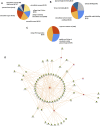Global and Comparative Proteome Signatures in the Lens Capsule, Trabecular Meshwork, and Iris of Patients With Pseudoexfoliation Glaucoma
- PMID: 35517867
- PMCID: PMC9065473
- DOI: 10.3389/fmolb.2022.877250
Global and Comparative Proteome Signatures in the Lens Capsule, Trabecular Meshwork, and Iris of Patients With Pseudoexfoliation Glaucoma
Abstract
Pseudoexfoliation (PXF) is characterized by the accumulation of the exfoliative material in the eye and high rates of blindness if left untreated. Pseudoexfoliation glaucoma (PXG) is generally diagnosed too late due to its asymptomatic nature, necessitating the development of new effective screening tools for the early diagnosis of the disease. Thus, the increasing prevalence of this disease due to an aging population has demanded the identification of suitable biomarkers for the early detection of the disease or detection of the onset of glaucoma in the eyes with PXF. We applied a proteomics strategy based on a high-throughput screening method for the determination of proteins involving PXF and PXG pathogenesis. The lens capsule (LC), iris, and trabecular meshwork (TM) samples with PXF and PXG were taken by surgical trabeculectomy, and control samples were taken from the donor corneal buttons obtained from the institutional eye bank to characterize the proteome profile. Peptides from the LC were analyzed using liquid chromatography with tandem mass spectrometry (LC-MS/MS). The protein of interest and cytokine/chemokine profiles were verified using immunohistochemistry and the bio-plex kit assay, respectively. There were a total of 1433 proteins identified in the human LC, of which 27 proteins were overexpressed and eight proteins were underexpressed in PXG compared with PXF. Overexpressed proteins such as fibromodulin, decorin, lysyl oxidase homolog 1, collagen alpha-1(I) chain, collagen alpha-3(VI) chain, and biglycan were the major components of the extracellular matrix (ECM) proteins involved in cell-matrix interactions or ECM proteoglycans and the assembly and cross-linking of collagen fibrils. The ECM composition and homeostasis are altered in glaucoma. Thus, quantitative proteomics is a method to discover molecular markers in the eye. Monitoring these events can help evaluate disease progression in future studies.
Keywords: extracellular matrix; iris; lens capsule; lysyl oxidase; mass spectroscopy; pseudoexfoliation; pseudoexfoliation glaucoma; trabecular meshwork.
Copyright © 2022 Sahay, Chakraborty and Rao.
Conflict of interest statement
The authors declare that the research was conducted in the absence of any commercial or financial relationships that could be construed as a potential conflict of interest.
Figures




Similar articles
-
Automated iris volume analysis and trabecular meshwork length using anterior segment optical coherence tomography - Application in pseudoexfoliation and pseudoexfoliation glaucoma.Indian J Ophthalmol. 2021 Jul;69(7):1815-1819. doi: 10.4103/ijo.IJO_2403_20. Indian J Ophthalmol. 2021. PMID: 34146036 Free PMC article.
-
TGFβ1, MMPs and cytokines profiles in ocular surface: Possible tear biomarkers for pseudoexfoliation.PLoS One. 2021 Apr 29;16(4):e0249759. doi: 10.1371/journal.pone.0249759. eCollection 2021. PLoS One. 2021. PMID: 33914756 Free PMC article.
-
A comparison of the corneal biomechanics in pseudoexfoliation syndrome, pseudoexfoliation glaucoma, and healthy controls using Corvis® Scheimpflug Technology.Indian J Ophthalmol. 2020 May;68(5):787-792. doi: 10.4103/ijo.IJO_1550_19. Indian J Ophthalmol. 2020. PMID: 32317447 Free PMC article.
-
The cellular and molecular biology of the iris, an overlooked tissue: the iris and pseudoexfoliation glaucoma.J Glaucoma. 2014 Oct-Nov;23(8 Suppl 1):S39-42. doi: 10.1097/IJG.0000000000000104. J Glaucoma. 2014. PMID: 25275904 Free PMC article. Review.
-
Proteomics of pseudoexfoliation materials in the anterior eye segment.Adv Protein Chem Struct Biol. 2021;127:271-290. doi: 10.1016/bs.apcsb.2021.03.004. Epub 2021 Apr 26. Adv Protein Chem Struct Biol. 2021. PMID: 34340770 Review.
Cited by
-
Lysyl oxidase-like 1-antisense 1 (LOXL1-AS1) lncRNA differentially regulates gene and protein expression, signaling and morphology of human ocular cells.Hum Mol Genet. 2023 Oct 17;32(21):3053-3062. doi: 10.1093/hmg/ddad128. Hum Mol Genet. 2023. PMID: 37540217 Free PMC article.
-
Role of Decorin in the Lens and Ocular Diseases.Cells. 2022 Dec 24;12(1):74. doi: 10.3390/cells12010074. Cells. 2022. PMID: 36611867 Free PMC article. Review.
-
Mitochondrial and microtubule defects in Exfoliation Glaucoma.Free Radic Biol Med. 2025 Jun;233:226-239. doi: 10.1016/j.freeradbiomed.2025.03.046. Epub 2025 Apr 1. Free Radic Biol Med. 2025. PMID: 40180018
-
Metabolite Analysis from Protein Deposits.Methods Mol Biol. 2025;2925:103-112. doi: 10.1007/978-1-0716-4534-5_6. Methods Mol Biol. 2025. PMID: 40498183 Review.
-
Aqueous humor metabolomic profiling identifies a distinct signature in pseudoexfoliation syndrome.Front Mol Biosci. 2025 Jan 23;11:1487115. doi: 10.3389/fmolb.2024.1487115. eCollection 2024. Front Mol Biosci. 2025. PMID: 39917180 Free PMC article.
References
-
- Anderson D. R., Hendrickson A. (1974). Effect of Intraocular Pressure on Rapid Axoplasmic Transport in Monkey Optic Nerve. Invest. Ophthalmol. 13, 771–783. - PubMed
-
- Babizhayev M. A. (2012). Biomarkers and Special Features of Oxidative Stress in the Anterior Segment of the Eye Linked to Lens Cataract and the Trabecular Meshwork Injury in Primary Open-Angle Glaucoma: Challenges of Dual Combination Therapy with N-Acetylcarnosine Lubricant Eye D. Fundam. Clin. Pharmacol. 26, 86–117. 10.1111/j.1472-8206.2011.00969.x - DOI - PubMed
LinkOut - more resources
Full Text Sources
Molecular Biology Databases

